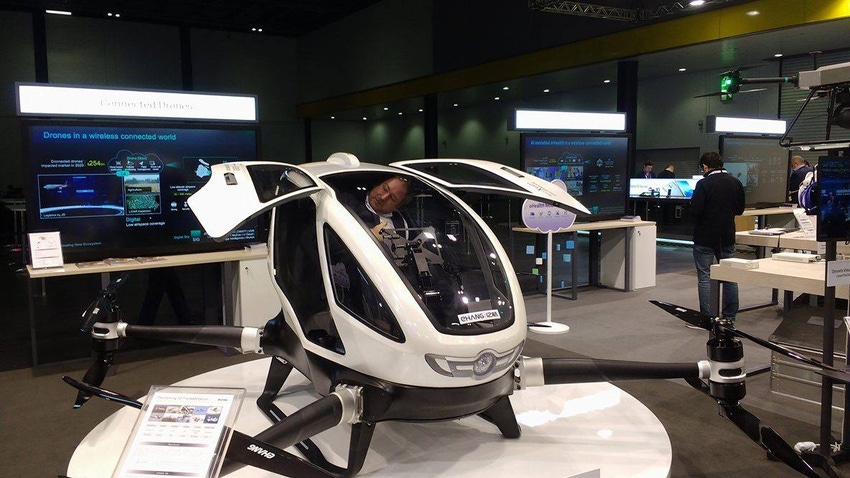Pessimism from the telcos doesn’t seemed to have dampened the enthusiasm of Huawei, as the team demonstrate flying taxis might be doable sooner than we think.
November 16, 2017

Pessimism from the telcos doesn’t seemed to have dampened the enthusiasm of Huawei, as the team demonstrate flying taxis might be doable sooner than we think.
Whenever you imagine the future there are numerous images which come to mind. Whether its holographs or robots running around everywhere, possibly more common is the idea of flying cars. This however has always been a pipe dream, but Huawei has shown it might not be as far away as we think.
Working alongside Chinese firm Ehang, the team brought a prototype of a single person, driverless, flying drone to London. It isn’t exactly what you imagined when it comes to a flying car, but it is a pretty impressive piece of kit. Due to licensing restrictions (the Excel is very close to London City Airport), the pair weren’t able to show us the ‘car’ in full flight here in London, but there was a video link to China where it took off and did a 200 metre round-trip.
Using four 4K cameras and four LiDARs, the ‘car’ can squeeze in, and we mean squeeze in, one passenger weighing less than 120kg, and make a trip of up to 41km, travelling at speeds of up to 100mph. The drone will go up to a maximum of 300 metres, of course depending on new standards and regulations. The initial idea will be as an alternative for taxis, but who knows where it could head next.
Standards and regulations can often be seen as a bit of a stumbling block of course, but that might not be the case here. During the conference, Huawei also announced the Digital Sky Initiative, a programme to spur on drone applications and enable the low airspace digitized economy via enhanced low airspace network coverage.
The Digital Sky Initiative will take place over three stages. Firstly, setting up connected drone application demo sites and promotes standardization of cellular-network-based management. Secondly, field tests and aims to achieve small-scale commercial use. And finally, delivering low airspace digital networks into commercial use, and provide network coverage for at least 30% of low airspace. Deployment in five countries might sound ambitious, but there is a lot of work going on behind the scenes.
The demonstration by Huawei and Ehang at the show highlighted it is technically possible, and the team plan to bring out a second prototype next year, but there are also other initiatives going one elsewhere. Uber, for instance, is working hard to bring its own version of the flying taxi to Dubai in the next year or two.
Taking over the skies will be immensely complicated from a management perspective, so don’t expect such a trend to be available for consumer vehicles in the near future, or ever, as there are too many idiots out there. And the connectivity challenge has not been fully satisfied, this will probably have to wait for 5G in most places. Aviation rules still need to be changed, and the consumer might not be ready for such a step forward as driverless, flying cars.
That said, the future doesn’t seem that far away anymore. Here’s a vid we took of the presentation.
About the Author(s)
You May Also Like








.png?width=300&auto=webp&quality=80&disable=upscale)


_1.jpg?width=300&auto=webp&quality=80&disable=upscale)


.png?width=800&auto=webp&quality=80&disable=upscale)